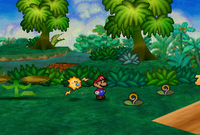Heart Plant: Difference between revisions
mNo edit summary |
Somethingone (talk | contribs) Tag: Mobile edit |
||
| (42 intermediate revisions by 30 users not shown) | |||
| Line 1: | Line 1: | ||
[[ | [[File:Heart Plant.png|frame|left]] | ||
[[File:Jade jungle.png|thumb|Mario and [[Watt]] near two Heart Plants]] | |||
The '''Heart Plant''' is a species of plant that is found during the events of ''[[Paper Mario]]''. It is a plant that has two leaves at the base, from which a brown question-mark-coiled stem stretches outward. | |||
These plants grow all over [[Lavalava Island]], especially deep in the [[Jade Jungle]]. [[Mario]] finds many of them during his search for the [[Fearsome 5|Baby Yoshi]]s that have gotten lost in the jungle. When Mario touches one of them, they uncoil and may drop a [[Heart (item)|heart]] that restores 1 [[Heart Point|HP]]. They have an infinite amount of hearts, so every time the player touches the plant, they may give another heart, even if Mario is at full HP level. | |||
[[Category: | However, the species is difficult to distinguish from the [[Hurt Plant]]s that duplicate the looks of the Heart Plant. The only way to find out what plant it may be is to inspect and uncoil it. If it ends up being a Hurt Plant, Mario will have to battle it. | ||
[[ | |||
==Tattle== | |||
*''A Heart Plant. These grow only on Lavalava Island. When you touch one, it gently stretches out its stem to welcome you. If you're lucky, it'll also give you a heart when it uncoils. Nice, huh? There's a species of mean plant that imitates it, though. Is this one good or bad?'' | |||
==Names in other languages== | |||
{{foreign names | |||
|Jap=ピロリン草<ref>[http://themushroomkingdom.net/pm_j-e.shtml "Paper Mario: From Japanese to English"]. (June 17, 2013). ''The Mushroom Kingdom.'' Retrieved February 4, 2015.</ref> | |||
|JapR=Pirorin Gusa | |||
|JapM={{wp|Pyrroline}} Grass | |||
|Ger=Herzzweig | |||
|GerM=Heart Bough | |||
}} | |||
==References== | |||
<references/> | |||
{{PM}} | |||
[[Category:Lavalava Island plants]] | |||
[[it:Heart Plant]] | |||
Revision as of 20:42, November 1, 2022

The Heart Plant is a species of plant that is found during the events of Paper Mario. It is a plant that has two leaves at the base, from which a brown question-mark-coiled stem stretches outward.
These plants grow all over Lavalava Island, especially deep in the Jade Jungle. Mario finds many of them during his search for the Baby Yoshis that have gotten lost in the jungle. When Mario touches one of them, they uncoil and may drop a heart that restores 1 HP. They have an infinite amount of hearts, so every time the player touches the plant, they may give another heart, even if Mario is at full HP level.
However, the species is difficult to distinguish from the Hurt Plants that duplicate the looks of the Heart Plant. The only way to find out what plant it may be is to inspect and uncoil it. If it ends up being a Hurt Plant, Mario will have to battle it.
Tattle
- A Heart Plant. These grow only on Lavalava Island. When you touch one, it gently stretches out its stem to welcome you. If you're lucky, it'll also give you a heart when it uncoils. Nice, huh? There's a species of mean plant that imitates it, though. Is this one good or bad?
Names in other languages
| Language | Name | Meaning |
|---|---|---|
| Japanese | ピロリン草[1] Pirorin Gusa |
Pyrroline Grass |
| German | Herzzweig |
Heart Bough |
References
- ^ "Paper Mario: From Japanese to English". (June 17, 2013). The Mushroom Kingdom. Retrieved February 4, 2015.